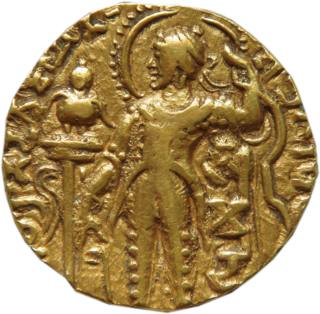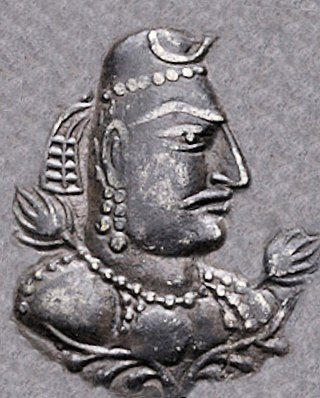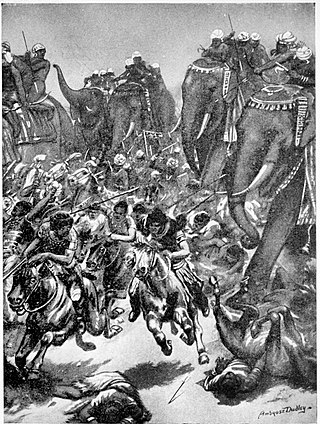The Gupta Empire was an Indian empire during the classical period of the Indian subcontinent which existed from the mid 3rd century to mid 6th century CE. At its zenith, the dynasty ruled over an empire that spanned much of the northern Indian subcontinent. This period has been considered as the Golden Age of India by some historians, although this characterisation has been disputed by others. The ruling dynasty of the empire was founded by Gupta.

Samudragupta (Gupta script: Sa-mu-dra-gu-pta, was the second emperor of the Gupta Empire of ancient India, and is regarded among the greatest rulers of India. As a son of the Gupta emperor Chandragupta I and the Licchavi princess Kumaradevi, he greatly expanded his dynasty's political and military power.

Kumaragupta I was Gupta emperor from 415 until his death in 455. A son of the Gupta king Chandragupta II and Queen Dhruvadevi, he seems to have maintained control of his inherited territory, which extended from Gujarat in the west to Bengal region in the east.

Ramagupta, according to the Sanskrit play Devichandraguptam, was an emperor of the Gupta dynasty of northern India. The surviving fragments of the play, combined with other literary evidence, suggest that he agreed to surrender his wife Dhruvadevi to a Shaka enemy: However, his brother Chandragupta II killed the Shaka enemy, and later dethroned him, marrying Dhruvadevi.

Skandagupta was a Gupta Emperor of India. His Bhitari pillar inscription suggests that he restored the Gupta power by defeating his enemies, who may have been rebels or foreign invaders. He repulsed an invasion by the Indo-Hephthalites, probably the Kidarites. He seems to have maintained control of his inherited territory, and is generally considered the last of the great Gupta Emperors. The Gupta genealogy after him is unclear, but he was most probably succeeded by Purugupta, who appears to have been his younger half-brother.

Eran is an ancient town and archaeological site in the Sagar district of Madhya Pradesh, India. It was one of the ancient mints for Indian dynasties as evidenced by the diverse coins excavated here. The site has 5th and 6th-century Gupta era temples and monuments, particularly the colossal stone boar with sages and scholars depicted on the body of the sculpture. The inscription stones found at Eran are important to reconstructing the chronology of Gupta Empire history. Eran or Erakina was the capital of Erakina (Airikina) Pradesha or Airkina Vishaya, an administrative division of the Gupta Empire.
There are conflicting theories regarding the original homeland and ancestry of the Gupta dynasty that ruled northern India between 4th and 6th centuries. Modern historians variously theorize that it originated in present-day Uttar Pradesh or Bengal, based on epigraphic, numismatic and literary evidence. The social group (varna) of the dynasty is also a matter of debate, with scholars variously placing them in Vaishya, Brahmana, or other categories.

Toramana also called Toramana Shahi Jauvla was a king of the Alchon Huns who ruled in northern India in the late 5th and the early 6th century CE. Toramana consolidated the Alchon power in Punjab, and conquered northern and central India including Eran in Madhya Pradesh. Toramana used the title "Great King of Kings", equivalent to "Emperor", in his inscriptions, such as the Eran boar inscription.

NarasimhaguptaBaladitya was the Gupta Emperor from 495 to 530 CE. He was son of Purugupta and probably the successor of Budhagupta.

Budhagupta was a Gupta emperor and the successor of Kumaragupta II. He was the son of Purugupta and was succeeded by Narasimhagupta.

Bhanugupta was one of the lesser known kings of the Gupta dynasty. He is only known from an inscription in Eran, and a mention in the Manjushri-mula-kalpa.

The Alchon Huns, also known as the Alkhan, Alchono, Alxon, Alkhon, Alakhana, and Walxon, were a nomadic people who established states in Central Asia and South Asia during the 4th and 6th centuries CE. They were first mentioned as being located in Paropamisus, and later expanded south-east, into the Punjab and Central India, as far as Eran and Kausambi. The Alchon invasion of the Indian subcontinent eradicated the Kidarite Huns who had preceded them by about a century, and contributed to the fall of the Gupta Empire, in a sense bringing an end to Classical India.

The Rīsthal inscription is a stone-slab inscription which was discovered in 1983 in the area of Rīsthal near Mandsaur in Madhya Pradesh, India.

The Eran boar inscription of Toramana, is a stone inscription found in Eran in the Malwa region of Madhya Pradesh, India. It is 8 lines of Sanskrit, the first three of which are in meter and the rest in prose, written in a North Indian script. It is carved on the neck of a freestanding 11 feet (3.4 m) high red sandstone Varaha statue, a zoomorphic iconography of Vishnu avatar, and dated to the 6th century. The inscription names king Toramana, ruler of the Alchon Huns, as ruling over Malwa and records that a Dhanyaviṣṇu is dedicating a stone temple to Narayana (Vishnu).

The Battle of Sondani was a large military encounter fought in 528 CE, between the Alchon Hun king Mihirakula and a confederation of Indian rulers led by King Yashodharman of Malwa and King Narasimhagupta of the Gupta Empire.

The Kingdom of Valabhi was an early medieval kingdom in Western India from 475 to 776. It was founded by Bhatarka, a general in the Gupta Empire, and ruled by the Maitraka dynasty.
The First Battle of Eran was a key engagement of the First Hunnic War that took place in 498 CE at Airikana (Eran), India. It was fought between the Gupta Empire and the invading army of Alchon Huns. The battle involved the Emperor Budhagupta, his viceroys, and Toramana, an acclaimed Hunnic king. The confrontation had significant consequences for the political and territorial situation in the region. The conflict concluded with a victory for the Alchon Huns that influenced subsequent events in the region.
The Second Battle of Eran, around 510 CE, marked a significant conflict between Emperor Bhanugupta of the Gupta Empire and the Huna invaders led by Toramana. The battle, commemorated in the Eran inscription, resulted in the death of Bhanugupta's general, Goparaja. It was pivotal in either halting the Huna advance into eastern Malwa or attempting to expel them from the region. The battle marked the first of a series of setbacks for the Huna conqueror. During his struggle against the invader, Bhanugupta may have received support from King Prakāśadharman, the ruler of Mandasor.

A Brahmin and a feudatory of the Gupta Empire, Mātṛviṣṇu is prominently mentioned in several inscriptions of Eran, Central India, who valiantly fought along with the emperor Bhanugupta in the First Battle of Eran in which he was martyred. In 484 CE, he is described as being a maharaja and the Vishayapati of Eran under the reign of Maharaja Surasmichandra, who governed the region between the Yamuna and the Narmada River. He comes from a family of pious Brahmins performing religious and spiritual duties; his grandfather was Indraviṣṇu and his forefather was Varuṇaviṣṇu, both known for their participation in studies of scripture and enactment of sacrificial rites.

Dhanyaviṣṇu was a local leader, a Brahmin and vassal under the Huna ruler Toramana, noted in the Eran Stone Boar Inscription from the early 6th century. He was the grandson of Maharaja Indravisnu and the younger sibling of Maharaja Mātṛviṣṇu. He is recognized for continuing the religious and architectural endeavors by his family. Dhanyaviṣṇu is particularly known for finishing a large Varaha statue and managing the building of a temple for Narayana at Eran, which is on the southern side of the River Bina. His survival after the Gupta Empire's fall and his choice to follow Toramana shows a time of political change and the ongoing hope during a period of declining power.

















